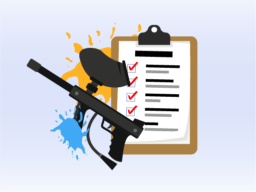What do you need for paintball? You’re in the right place.
The equipment you need to play
This guide covers 33 things the paintball pro uses broken up into three categories: 13 Absolute Essentials, 10 Personal Must-Haves, and 10 Nice-to-Haves.
Think an essential piece of paintball gear is missing? Let me know.
Let’s jump right in.
13 Absolute Essentials
There’s a lot of paintball gear out there, some of which is completely unnecessary for the casual or beginner player. But these 13 things? You absolutely have to have them.
1. Paintball marker
There are a lot of different types of paintball guns, but they all come down to three main modes of action:
- Pump
- Mechanical
- Electric
Regardless of the type of marker you use or how much it costs, you’ll definitely need one.
(Unless you plan on being everyone else’s target.)
Our guide to the 11 Best Paintball Guns has our favorite spring, gas blowback, non-blowback, and electronic markers.
2. Paintball mask
A paintball mask is a necessary piece of safety gear that can have a major impact on your play, either positive or negative. The best paintball masks have a wide field of vision, resist fogging, and are comfortable to wear with good ventilation. Some masks also have interchangeable lenses to give you better vision based on whether you’re playing in bright sun, under overcast skies, or indoors.
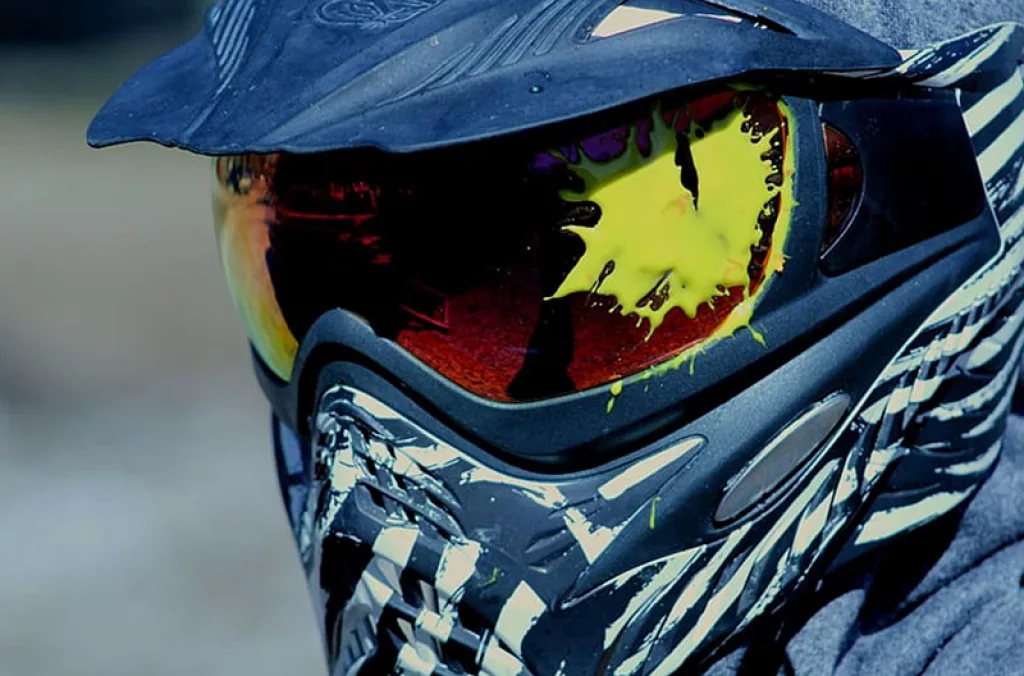
3. Hopper
The hopper is the container that attaches to the top of your marker and holds your paintballs. There are two main types:
- Gravity-fed
- Electronic
Gravity-fed hoppers are less expensive but only feed paintballs at a rate of 10-12 per second whereas electronic hoppers use a motorized paddle or other battery-powered mechanism to feed paintballs as quickly as 20 per second. For pump and mechanical paintball markers, a gravity-fed hopper will be fine, but you’ll want an electronic hopper to make the most of your high-capacity electronic paintball marker. Check out our write-up on the best paintball hoppers for more details.
4. Barrel cover
Paintball barrel covers have two crucial jobs:
- Keep dirt and debris out of your barrel so your marker stays clean and fires consistently
- Prevent any unwanted firing for safety purposes
Some markers come with barrel plugs instead of covers, but actual barrel covers usually are required at paintball venues for the aforementioned safety reasons.
5. CO2 or HPA tank
CO2 and HPA (high pressured air) are the propellants that fire your paintballs downfield. CO2 tanks usually are less expensive, both to purchase and refill, but have more inconsistent pressure when firing and can damage rubber seals with drastic temperature fluctuations. HPA tanks are more expensive, harder to refill if you aren’t near a local paintball pro shop, and tend to be larger, heavier, and bulkier. However, they deliver consistent pressure and firing velocity.
6. Paintballs
The paintball itself is a pretty important piece of gear! Made of a hard outer shell with liquid paint inside, it’s important not to skimp on these. The ideal paintball will be firm enough to resist breaking when fired but soft enough to splatter on impact. Low quality paintballs tend to break at inopportune times, including in your barrel, and make even the most accurate shooters look like rookies. Click here to learn about the best paintballs.
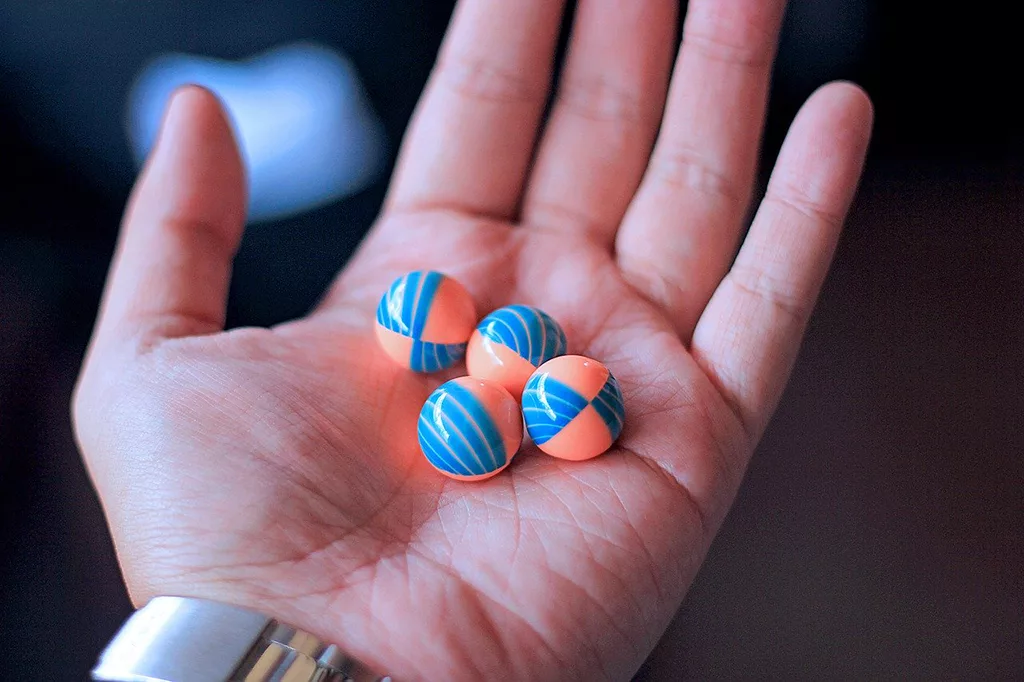
7. Pod pack, harness, tactical vest, or tactical belt
Unless you’re a hyper-conservative player, chances are you’ll need to refill your hopper during play. Having the right pod pack, harness, vest, or belt to hold extra paint will make the refilling process fast and simple without hindering your mobility. Tactical vests, in particular, are great options because they offer tons of storage with additional protection against hits in a stylish-yet-realistic package.
8. Head protection
Whether it’s a helmet, hoodie, hat, or scarf, you’ll want an extra layer between incoming paintballs and your head to reduce the pain of impact.
9. Neck protection
The same goes for your neck, an especially painful part of your body to suffer a direct hit. A lightweight scarf will suffice as actual paintball neck protectors tend to add bulk, limit mobility, and reduce comfort for the relatively low chance you’ll take a hit here.
10. Loose clothing
Unless you’re looking to kick start a new trend of paintball in the buff, you’re going to need some clothing. Looser is better. Not only does it minimize the pain of getting hit, but loose clothing often causes deflections and sometimes prevents hits from breaking on you. Whatever you wear, it should be comfortable and allow you to move freely.
Our guide to 13 Key Pieces of Paintball Clothing has everything you need to know.
And don’t forget to check out our guide to the 11 Best Tactical Boots if you want better performance than a cheap pair of gym sneakers.
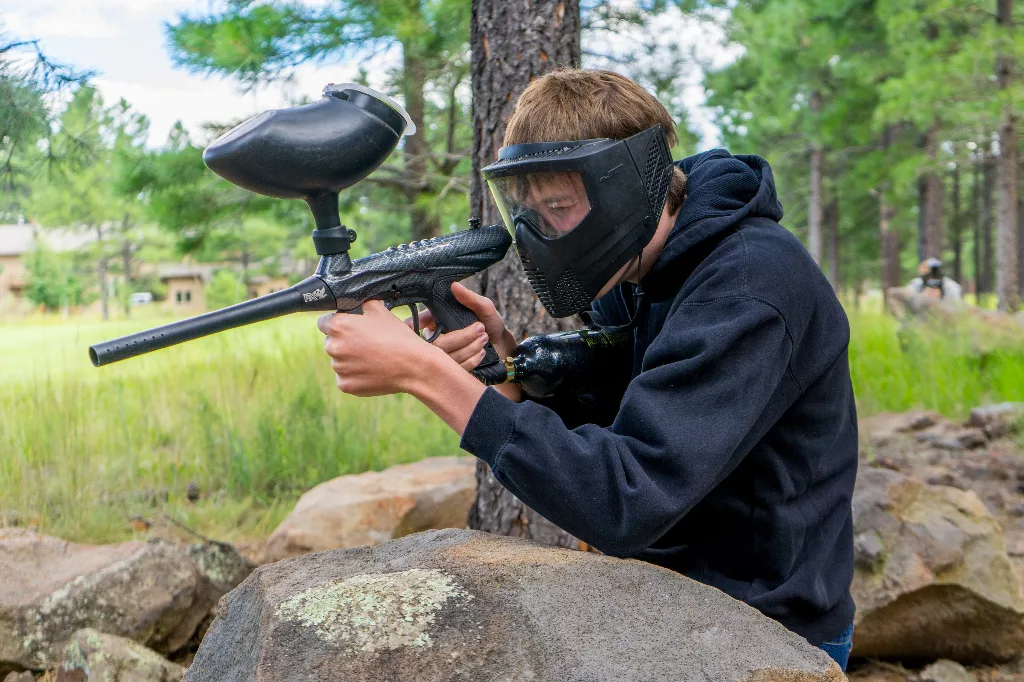
11. Water
Generally, you want as little exposed skin as possible. That means you’re fully covered, even on hot days, while maneuvering your way to victory. You’ll be sweating, so water is essential.
12. Gear bag
We’ve already covered 11 things on this paintball gear list. You’re going to need something to put it all in.
13. Cash
Many venues are cash only, so it always helps to have some on hand.
10 Personal Must-Haves
You can get away without having these 10 items, but I wouldn’t recommend it.
14. Gloves
To glove or not to glove, that is the question. The paintball community is split on this one. On the one hand (pun intended), your hands are among the most hit body parts as you’re continually exposing them when you fire downfield. Any kind of glove offers protection against impacts. On the other hand, some people hate how gloves interfere with their touch and firing ability.
15. First-aid kit with bandages
Cuts, scrapes, twisted ankles, and other injuries are common on the paintball field. A basic first-aid kit should include a few types of bandages, alcohol disinfecting wipes, tweezers, small scissors, gauze, a small roll of medical tape, and antiseptic cream.
16. Squeegee for gun barrel
It may not happen often, but sooner or later a paintball will break inside your barrel. If not cleaned properly, you’ll see your accuracy plummet and suffer further breaks. There are three types of squeegees:
- Pull-through squeegee
- Stick squeegee
- Folding swab
Pull-through squeegees do the best job but require you to disassemble your marker and thus are impractical on the field. Stick squeegees and folding swabs can be used the heat of battle until you have a chance to do a thorough cleaning later. Ideally, you’ll have all three.
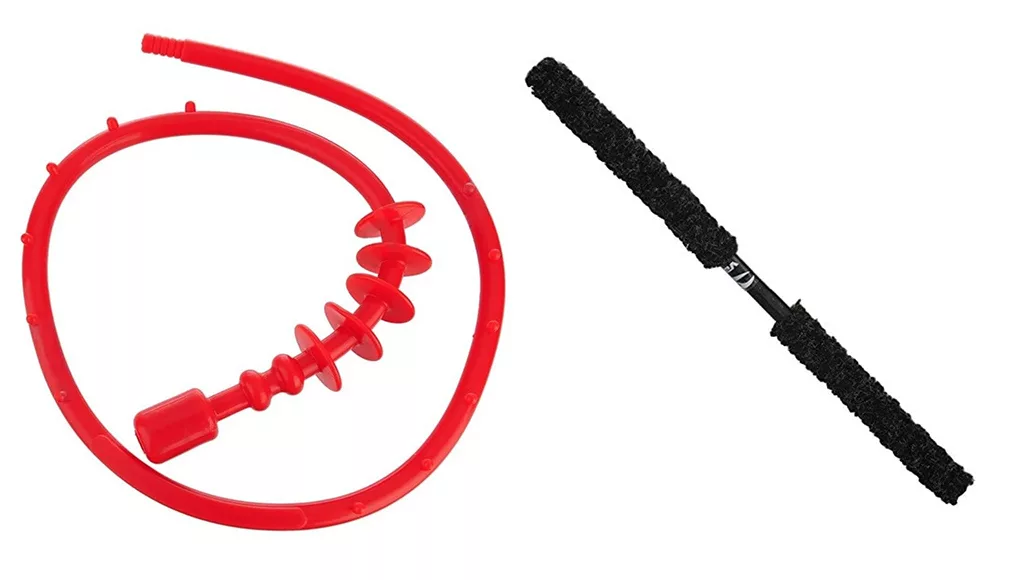
17. Compact binoculars
Woodsball players are tasked with surveying a large area with opponents intentionally trying to be stealthy and deceptive. A good pair of compact binoculars can give you the upper hand as you plan your next move.
Our guide to the 11 Best Compact Binoculars has something for all field types.
18. Tools and spare parts like o-rings and cup seals
Nothing’s worse than having your day end early because an o-ring failed. They’re inexpensive to carry, simple to replace, and are just a common sense item to keep on you. Make sure you have at least one of each type of o-ting on your setup. Keep some gun oil on you too for proper lubrication.
19. Lens cleaner spray
Dirty mask lenses make it harder to play. While you may think it’s fine to use Windex to wipe them clean, household cleaners can actually degrade the lens material and strip away protective layers and anti-glare coating. Water will suffice, but manufacturer-approved lens cleaner is your best bet.
20. Batteries
If you have battery-powered gear, it’s always a great idea to carry spare batteries.
21. Electrical or hockey tape
Things go wrong on the battlefield, and sometimes there’s no time for a proper fix. Electrical or hockey tape can be a lifesaver when something needs to be lashed together on the fly. Plus, it fits well in your harness, vest, or belt.
22. Extra clothes
Unless you enjoy getting paint everywhere, you’re going to want a clean change of clothes.
23. Garbage bag
You’re also going to want something to put those dirty clothes and towels in.
10 Nice-To-Haves
Maximize both your fun and effectiveness with these 10 nice-to-have pieces of paintball gear.
24. Backup paintball gun/marker
For intermediate or experienced players, having a backup marker is a nice luxury in case something unforeseen happens. Beginners often purchase an inexpensive, basic first marker and upgrade later, keeping the original as a backup.
25. Knee, elbow, and forearm pads
Not everyone likes the bulk of extra padding, but proper knee, elbow, and forearm pads offer extra layers of protection for players who do a lot of sliding and crawling. Few things hurt more on the paintball field than running your knee into a tree root without proper padding.
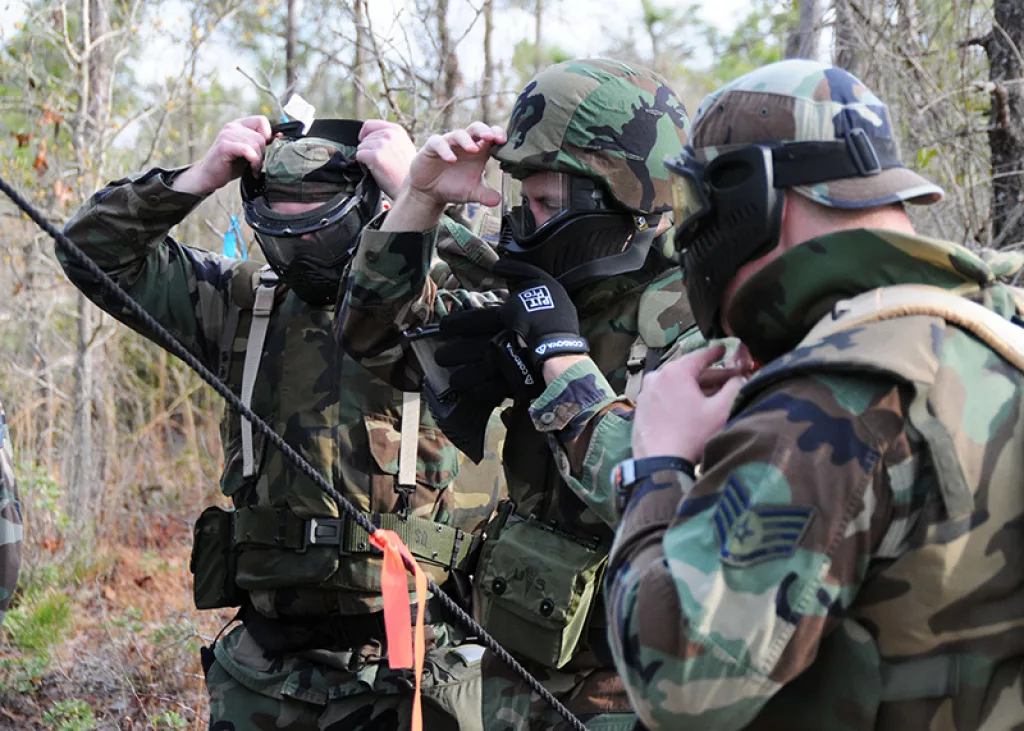
26. Bug spray
You’re already fighting off enough attackers on the paintball field, so why worry about mosquitoes and other biting insects?
27. Sunscreen
While most players already cover as much skin as possible, the ears and back of the neck are frequently exposed. If you’ll be playing all day in the sun, look for a waterproof sunscreen with SPF 30 or higher.
28. Talcum powder
Warm weather plus lots of clothing and movement means plenty of sweat. Talcum powder can help keep you dry, especially your hands, for a better grip and more comfortable play.
29. Hydration pack
Water is an absolute necessity, and it’s great to have a portable hydration pack to stay hydrated during play. Some hydration packs have bite valves that make it simple to stay hydrated during long sessions in hot weather.
30. Carabineers
I take carabineers wherever I go, so why not take them paintballing? They easily clip to harnesses, vests, or belts and help you secure handy accessories.
31. Cooler for paintballs
Paintballs are best stored in dark, cool, dry places. A cooler can come in handy on hot, humid days because high temperature and water are especially terrible for paint. If you’re playing in these conditions, store your paintballs in a large cooler with couple of frozen bottles of water, keeping the two as far apart as possible.
32. Remote line for paintballs
Remote lines allow you to remove heavy air tanks from your gun and place them on your body with a hose connecting the remote tank to the marker. For the most part they’re totally unnecessary, often get caught on objects as you’re moving, and removing the air tank may even hinder your marker’s balance. The only time they may be worth it is if you have an especially heavy tank.
33. Paintball grenades
Yes, paintball grenades are a thing. They’re useful in two situations:
- Scattering enemies behind a barricade
- Eliminating multiple targets at once
Some players find them tricky and cumbersome to use, but they can dramatically alter a game when used properly.
Frequently Asked Questions
What equipment do you need to play paintball?
• Paintball marker
• Paintball mask
• Hopper
• Barrel cover
• CO2 or HPA tank
• Paintballs
• Pod pack, harness, tactical vest, or tactical belt
• Head protection
• Neck protection
• Loose clothing
Water
• Gear bag
• Cash
What paintball gear is strongly recommended?
• Gloves
• First-aid kit with bandages
• Squeegee for gun barrel
• Compact binoculars
• Tools and spare parts like o-rings and cup seals
• Lens cleaner spray
• Batteries
• Electrical or hockey tape
• Extra clothes
• Garbage bag
Which paintball accessories are nice-to-have?
• Backup paintball gun/marker
• Knee, elbow, and forearm pads
• Bug spray
• Sunscreen
• Talcum powder
• Hydration pack
• Carabineers
• Cooler for paintballs
• Remote line for paintballs
• Paintball grenades
Do paintball places give you gear?
Yes – you can rent gear or bring your own. Some places will offer upgraded packages that will give you things like a better marker or more paint.
How long will 100 paintballs last?
It totally depends on the action and how trigger happy you are! A player can go through 100 paintballs in as little as ten minutes or make them last as long as three hours.
What is the most common paintball size?
68 caliber (17.3 MM) is considered standard.
